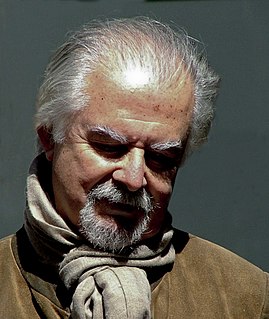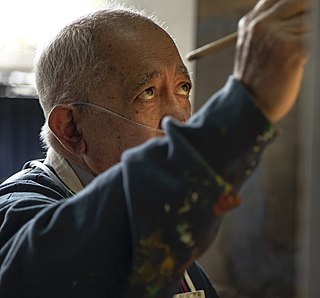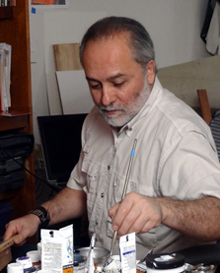Related Research Articles

Fernando Botero Angulo is a Colombian figurative artist and sculptor, born in Medellín. His signature style, also known as "Boterismo", depicts people and figures in large, exaggerated volume, which can represent political criticism or humor, depending on the piece. He is considered the most recognized and quoted living artist from Latin America, and his art can be found in highly visible places around the world, such as Park Avenue in New York City and the Champs-Élysées in Paris.

Juan Soriano was a Mexican artist known for his paintings, sculptures and theater work. He was a child prodigy whose career began early as did his fame with various writers authoring works about him. He exhibited in the United States and Europe as well as major venues in Mexico such as the Museo de Arte Moderno and the Palacio de Bellas Artes. His monumental sculptures can be found in various parts of Mexico and in Europe as well. Recognitions of his work include Mexico's National Art Prize, the Chevalier des Arts et Lettres and membership in France's Legion of Honour.

Francisco Benjamín López Toledo, known as Francisco Toledo, was a Mexican Zapotec painter, sculptor, and graphic artist. In a career that spanned seven decades, Toledo produced thousands of works of art and became widely regarded as one of Mexico's most important contemporary artists. An activist as well as an artist, he promoted the artistic culture and heritage of his home state of Oaxaca. Toledo was considered part of the Breakaway Generation of Mexican art.

Olga de Amaral is a Colombian textile and visual artist known for her large-scale abstract works made with fibers and covered in gold and/or silver leaf. Because of her ability to reconcile local concerns with international developments, de Amaral became one of the few artists from South America to become internationally known for her work in fiber during the 1960s and ‘70s. She is also considered an important practitioner in the development of postwar Latin American Abstraction. She currently lives and works in Bogotá, Colombia.
Luis Camnitzer is a German-born Uruguayan artist, curator, art critic, and academic who was at the forefront of 1960s Conceptual Art. Camnitzer works primarily in sculpture, printmaking, and installation, exploring topics such as repression, institutional critique, and social justice. For over five decades, his practice has explored the psychological and political dimensions of language.

Andrés de Santa Maria was the most internationally known Colombian painter of his time and the pioneer of impressionism in Colombia. His work in solitary as a vanguardist painter frames the beginnings of modern art in Colombia. Santa Maria's search for new artistic expressions generated rejection and controversies around his work. He lived a great part of his life in Europe.

Pedro Pablo Restrepo-Peláez is a Colombian artist, civil servant, art historian and writer.

Ricardo Acevedo Bernal was a Colombian portrait painter, composer and photographer.
Herminio Feliciano Peña Aguilera was a Mexican painter and engraver. His work was recognized with membership in the Salón de la Plástica Mexicana and was a founding member of the Sociedad Mexicana de Grabadores.
Luis Ortiz Monasterio was a Mexican sculptor noted for his monumental works such as the Monumento a la Madre and the Nezahualcoyotl Fountain in Chapultepec Park. His work was recognized in 1967 with the Premio Nacional de Artes and was a founding member of the Academia de Artes.
Antonio M. Ruíz, was a Mexican fine art painter and scenic designer otherwise known by his childhood nickname "El Corzo" or "El Corcito" (diminutive) which came about due to his resemblance to a popular Spanish bullfighter or torero.

Gilberto Aceves Navarro was a Mexican painter and sculptor and a professor at the Escuela Nacional de Artes Plásticas and Academy of San Carlos. There have been more than two hundred individual exhibits of his work, with his murals found in Mexico, Japan and the United States. He received numerous awards for his work including grants as a Creador Artístico of the Sistema Nacional de Creadores de Arte, Premio Nacional de Ciencias y Artes and Bellas Artes Medal from the Instituto Nacional de Bellas Artes.

Liliana Porter is a contemporary artist working in a wide variety of media, including photography, printmaking, painting, drawing, installation, video, theater, and public art.

Julio Vicente Agapito Abril Mayorga was a Colombian sculptor, painter, and draughtsman.
Antonio Rodríguez Luna was a Spanish painter who developed most of his career while in exile in Mexico during the Spanish Civil War. He began his career young, while still studying in Madrid and before the war had already exhibited in various places in Europe. His opposition to Francisco Franco, forced him into exile, with intellectuals and artists in the country arranging his asylum. His career here included a Guggenheim Fellowship with major exhibitions in Washington DC and New York along with exhibitions at the Museo de Arte Moderno and the Palacio de Bellas Artes in Mexico. Despite his success, he never forgot his Spanish roots, with an exhibition in Madrid in 1971 and a return to his hometown of Montoro in 1981, after the death of Franco.
Enrique Echeverría Vázquez (1923–1972) was a Mexican painter, part of the Generación de la Ruptura and early member of the Salón de la Plástica Mexicana. He was one of a number of painters who broke away from the established painting figurative style in Mexico in the mid 20th century to experiment with abstractionism and other modern movements in painting from Europe. Although his career was followed by other artists and critics, he died in the early 1970s when painters of his generation were only beginning to receive widespread recognition for their work. While meriting two major exhibits at the Palacio de Bellas Artes in Mexico City, one just after his death and a retrospective thirty years later in 2003, he and his work are not well known among younger Mexican painters.
Tomás Parrá is a Mexican artist, cultural promoter and museum curator. His work has been noted with membership into Mexico Sistema Nacional de Creadores de Arte.

Fanny Sanín Sader is a Colombian born artist from Bogotá who resides in New York City. The daughter of Gabriel Sanín Tobón and Fanny Sader Guerra, she is best known for her paintings of abstract geometric forms and colors. She is considered to be part of the second generation of abstract artists from Colombia.

Alberto Gómez Gómez is a figurative artist, painter and master print maker. Born in Bogotá, Colombia, Gómez Gómez became a citizen of the United States on July 29, 2011. He is best known for producing monumentally scaled murals in the United States and Colombia. His art can also be found in private collections throughout the European capitals of Spain, Belgium, South Africa, Russia, Germany, the United Kingdom, and Italy. His signature style depicts people, figures, and daily life. His works often address spiritual, social, philosophical, historical, and political events and issues, although often in a humorous way.

Hena Rodríguez was one of the first Colombian women to become a sculptor. She taught at the National University of Colombia and University of Los Andes, before becoming the founding dean of the Faculty of Arts at the latter institution. Her sculpture Cabeza de Negra is in the collection of the Colombian National Museum and a painting Espalda is part of the Art Collection of the Bank of the Republic.
References
- 1 2 3 4 5 6 7 8 9 "El Escultor Guillermo Silva Expone Desde Hoy 24 Obras en El Jardin Botanico la Concepcion" (in Spanish). Malagaes, Spain: Noticia de Malagaes. 20 April 2007. Archived from the original on 31 August 2011. Retrieved 25 April 2015.
- ↑ "Guillermo Silva Santamaria". van Dyk Gallery. van Dyk Gallery. Retrieved 25 April 2015.
- 1 2 Moreno Clavijo, Jorge (1966). "Un artista andariego: El pintor Guillermo Silva". Boletín Cultural y Bibliográfico (in Spanish). Bogotá, Colombia: Subgerencia Cultural del Banco de la República. 9 (4): 740–741. Retrieved 25 April 2015.
- 1 2 3 4 "Diccionario de Artistas en Colombia, Letra S, Parte 3" (in Spanish). Bogotá, Colombia: Subgerencia Cultural del Banco de la República. Retrieved 25 April 2015.
- 1 2 "An Exhibition of Etchings". Phoenix, Arizona: Arizona Republic. 9 November 1969. p. 217. Retrieved 25 April 2015.
- 1 2 3 4 "Cassidy Gallery Exhibits Works of Guillermo Silva Santamaria". Albuquerque, New Mexico: Albuquerque Journal. 14 January 1973. p. 26. Retrieved 25 April 2015.
- ↑ "Guillermo Silva Santamaria's 'The Law of the Strongest' Fantasy and Humor Mark His Cassidy Gallery Exhibit". Albuquerque, New Mexico: Albuquerque Journal. 20 January 1974. p. 25. Retrieved 25 April 2015.
- ↑ Montero, Esteban (2007). "Silva" (PDF). Aehcos Magazine (in Spanish). Málaga, Spain: Asociación de Empresarios Hoteleros de la Costa del Sol: 25–27. Retrieved 25 April 2015.
- ↑ "Guillermo Silva Santamaria Biography". The Annex Galleries. Santa Rosa, California: The Annex Galleries. Retrieved 25 April 2015.
- ↑ Christensen, Anne Gro (21 June 2007). "Ingen sommer uten Silva" (in Norwegian). Hønefoss, Norway: Ringerikes Blad. Retrieved 25 April 2015.
- ↑ Christensen, Anne Gro (3 July 2007). "Silva er død" (in Norwegian). Hønefoss, Norway: Ringerikes Blad. Retrieved 25 April 2015.